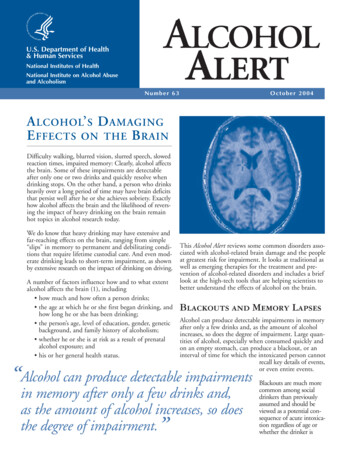
Transcription
U.S. Department of Health& Human ServicesNational Institutes of HealthNational Institute on Alcohol Abuseand AlcoholismNumber 63October 2004A LCOHOL’ S D AMAGINGE FFECTS ON THE B RAINDifficulty walking, blurred vision, slurred speech, slowedreaction times, impaired memory: Clearly, alcohol affectsthe brain. Some of these impairments are detectableafter only one or two drinks and quickly resolve whendrinking stops. On the other hand, a person who drinksheavily over a long period of time may have brain deficitsthat persist well after he or she achieves sobriety. Exactlyhow alcohol affects the brain and the likelihood of revers ing the impact of heavy drinking on the brain remainhot topics in alcohol research today.We do know that heavy drinking may have extensive andfar-reaching effects on the brain, ranging from simple“slips” in memory to permanent and debilitating condi tions that require lifetime custodial care. And even mod erate drinking leads to short-term impairment, as shownby extensive research on the impact of drinking on driving.A number of factors influence how and to what extentalcohol affects the brain (1), including how much and how often a person drinks; the age at which he or she first began drinking, andhow long he or she has been drinking; the person’s age, level of education, gender, geneticbackground, and family history of alcoholism; whether he or she is at risk as a result of prenatalalcohol exposure; and his or her general health status.This Alcohol Alert reviews some common disorders asso ciated with alcohol-related brain damage and the peopleat greatest risk for impairment. It looks at traditional aswell as emerging therapies for the treatment and pre vention of alcohol-related disorders and includes a brieflook at the high-tech tools that are helping scientists tobetter understand the effects of alcohol on the brain.Blackouts and Memory LapsesAlcohol can produce detectable impairments in memoryafter only a few drinks and, as the amount of alcoholincreases, so does the degree of impairment. Large quan tities of alcohol, especially when consumed quickly andon an empty stomach, can produce a blackout, or aninterval of time for which the intoxicated person cannotrecall key details of events,or even entire events.“Alcohol can produce detectable impairmentsin memory after only a few drinks and,as the amount of alcohol increases, so doesthe degree of impairment.”Blackouts are much morecommon among socialdrinkers than previouslyassumed and should beviewed as a potential con sequence of acute intoxica tion regardless of age orwhether the drinker is
clinically dependent on alcohol (2). White and colleagues(3) surveyed 772 college undergraduates about theirexperiences with blackouts and asked, “Have you everawoken after a night of drinking not able to rememberthings that you did or places that you went?” Of thestudents who had ever consumed alcohol, 51 percentreported blacking out at some point in their lives, and40 percent reported experiencing a blackout in the yearbefore the survey. Of those who reported drinking inthe 2 weeks before the survey, 9.4 percent said theyblacked out during that time. The students reportedlearning later that they had participated in a wide rangeof potentially dangerous events they could not remem ber, including vandalism, unprotected sex, and driving.women metabolize alcohol. Females also may be moresusceptible than males to milder forms of alcoholinduced memory impairments, even when men andwomen consume comparable amounts of alcohol (4).Are Women MoreVulnerable to Alcohol’sEffects on the Brain?Women are more vulnerable than men to many of themedical consequences of alcohol use. For example,alcoholic women develop cirrhosis (5), alcohol-induceddamage of the heart muscle (i.e., cardiomyopathy) (6),and nerve damage (i.e., peripheral neuropathy) (7) afterfewer years of heavy drinking than do alcoholic men. Studiescomparing men and women’s sensitivity to alcohol-inducedbrain damage, however, have not been as conclusive.Binge Drinking and Blackouts Drinkers who experience blackoutstypically drink too much and tooquickly, which causes their bloodalcohol levels to rise very rapidly.College students may be at particularrisk for experiencing a blackout,as an alarming number of collegestudents engage in binge drinking.Binge drinking, for a typical adult,is defined as consuming five or moredrinks in about 2 hours for men,or four or more drinks for women.Using imaging with computerized tomography, twostudies (8,9) compared brain shrinkage, a commonindicator of brain damage, in alcoholic men and womenand reported that male and female alcoholics bothshowed significantly greater brain shrinkage than con trol subjects. Studies also showed that both men andwomen have similar learning and memory problems asa result of heavy drinking (10). The difference is thatalcoholic women reported that they had been drinkingexcessively for only about half as long as the alcoholicmen in these studies. This indicates that women’s brains,like their other organs, are more vulnerable to alcoholinduced damage than men’s (11).Yet other studies have not shown such definitive find ings. In fact, two reports appearing side by side inthe American Journal of Psychiatry contradicted eachother on the question of gender-related vulnerabilityto brain shrinkage in alcoholism (12,13). Clearly, moreresearch is needed on this topic, especially because alco holic women have received less research attention thanalcoholic men despite good evidence that women maybe particularly vulnerable to alcohol’s effects on manykey organ systems.Equal numbers of men and women reported experi encing blackouts, despite the fact that the men dranksignificantly more often and more heavily than thewomen. This outcome suggests that regardless of theamount of alcohol consumption, females—a groupinfrequently studied in the literature on blackouts—are at greater risk than males for experiencing blackouts. A woman’s tendency to black out more easilyprobably results from differences in how men and“Heavy drinking may have extensiveand far-reaching effects on the brain,ranging from simple ‘slips’ in memoryto permanent and debilitating conditionsthat require lifetime custodial care.”2Brain DamageFrom OtherCausesPeople who have beendrinking large amounts ofalcohol for long periods oftime run the risk of devel oping serious and persist ent changes in the brain.
Using High-Tech Tools to AssessAlcoholic Brain DamageResearchers studying the effects ofalcohol use on the brain are aided byadvanced technology such as magneticresonance imaging (MRI), diffusiontensor imaging (DTI), positron emission tomography (PET), and electrophysiological brain mapping. Thesetools are providing valuable insightinto how alcohol affects the brain’sstructure and function.Average EPP for Channel CZ14121086420-2-184Control e (ms)Long-term heavy drinking may lead toshrinking of the brain and deficienciesThe P3 component is reduced in alcoholics comparedin the fibers (white matter) that carrywith control subjects.information between brain cells (graymatter). MRI and DTI are being usedtogether to assess the brains of patients when they first stop chronic heavy drinking and again after long periodsof sobriety, to monitor for possible relapse to drinking (38).Memory formation and retrieval are highly influenced by factors such as attention and motivation (39). Studies usingMRI are helping scientists to determine how memory and attention improve with long-time abstinence from alcohol,as well as what changes take place when a patient begins drinking again. The goal of these studies is to determinewhich alcohol-induced effects on the brain are permanent and which ones can be reversed with abstinence.PET imaging is allowing researchers to visualize, in the living brain, the damage that results from heavy alcoholconsumption (40). This “snapshot” of the brain’s function enables scientists to analyze alcohol’s effects on variousnerve cell communication systems (i.e., neurotransmitter systems) as well as on brain cell metabolism and bloodflow within the brain. These studies have detected deficits in alcoholics, particularly in the frontal lobes, whichare responsible for numerous functions associated with learning and memory, as well as in the cerebellum, whichcontrols movement and coordination. PET also is a promising tool for monitoring the effects of alcoholism treatment and abstinence on damaged portions of the brain and may help in developing new medications to correctthe chemical deficits found in the brains of people with alcohol dependence.Another high-tech tool, electroencephalography (EEG), records the brain’s electrical signals (41). Small electrodesare placed on the scalp to detect this electrical activity, which then is magnified and graphed as brain waves (i.e.,neural oscillations). These brain waves show real-time activity as it happens in the brain.Many male alcoholics have a distinctive electrophysiological profile—that is, a low amplitude of their P3 components (see figure). P3 amplitudes in women alcoholics also are reduced, although to a lesser extent than in men.For many years it was assumed that the P3 deficit observed in alcoholics was the result of alcohol’s damage to thebrain. Then it was determined that while many of the clinical symptoms and electrophysiological measures associated with alcoholism return to normal after abstinence, the P3 amplitude abnormality persists (42).This continued deficit in long-term abstinent alcoholics suggests that P3 deficits may be a marker of risk foralcohol dependence, rather than a result of alcohol use. In fact, a number of studies have since reported low P3amplitudes in young people who have not started drinking alcohol but who are at high risk for developing alcoholism, such as young sons of alcoholic fathers (43,44). Markers such as the P3 can help identify people whomay be at greatest risk for developing problems with alcohol.3
Damage may be a result of the direct effects of alcoholon the brain or may result indirectly, from a poor gen eral health status or from severe liver disease.Human BrainCerebral cortex{For example, thiamine deficiency is a common occur rence in people with alcoholism and results from pooroverall nutrition. Thiamine, also known as vitaminB1, is an essential nutrient required by all tissues,including the brain. Thiamine is found in foods suchas meat and poultry; whole grain cereals; nuts; anddried beans, peas, and soybeans. Many foods in theUnited States commonly are fortified with thiamine,including breads and cereals. As a result, most peopleconsume sufficient amounts of thiamine in their diets.The typical intake for most Americans is 2 mg/day; theRecommended Daily Allowance is 1.2 mg/day for menand 1.1 mg/day for women (14).Parietal beWernicke–Korsakoff SyndromeUp to 80 percent of alcoholics, however, have a defi ciency in thiamine (15), and some of these peoplewill go on to develop serious brain disorders such asWernicke–Korsakoff syndrome (WKS) (16). WKS isa disease that consists of two separate syndromes, ashort-lived and severe condition called Wernicke’sencephalopathy and a long-lasting and debilitatingcondition known as Korsakoff ’s psychosis.Schematic drawing of the human brain,showing regions vulnerable to alcoholismrelated abnormalities.Patients with Korsakoff ’s psychosis are forgetful andquickly frustrated and have difficulty with walking andcoordination (17). Although these patients have prob lems remembering old information (i.e., retrogradeamnesia), it is their difficulty in “laying down” newinformation (i.e., anterograde amnesia) that is themost striking. For example, these patients can discussin detail an event in their lives, but an hour latermight not remember ever having the conversation.The symptoms of Wernicke’s encephalopathy includemental confusion, paralysis of the nerves that movethe eyes (i.e., oculomotor disturbances), and difficultywith muscle coordination. For example, patients withWernicke’s encephalopathy may be too confused tofind their way out of a room or may not even be ableto walk. Many Wernicke’s encephalopathy patients,however, do not exhibit all three of these signs andsymptoms, and clinicians working with alcoholicsmust be aware that this disorder may be present evenif the patient shows only one or two of them. In fact,studies performed after death indicate that many casesof thiamine deficiency–related encephalopathy maynot be diagnosed in life because not all the “classic”signs and symptoms were present or recognized.Treatment—The cerebellum, an area of the brainresponsible for coordinating movement and perhapseven some forms of learning, appears to be particularlysensitive to the effects of thiamine deficiency and isthe region most frequently damaged in associationwith chronic alcohol consumption. Administering thi amine helps to improve brain function, especially inpatients in the early stages of WKS. When damage tothe brain is more severe, the course of care shifts fromtreatment to providing support to the patient and hisor her family (18). Custodial care may be necessary forthe 25 percent of patients who have permanent braindamage and significant loss of cognitive skills (19).Approximately 80 to 90 percent of alcoholics withWernicke’s encephalopathy also develop Korsakoff ’spsychosis, a chronic and debilitating syndrome charac terized by persistent learning and memory problems.“Patients with Wernicke’s encephalopathymay be too confused to find their way outof a room or may not even be able to walk.”4Scientists believe thata genetic variationcould be one explana tion for why onlysome alcoholics withthiamine deficiency goon to develop severeconditions such as
Alcohol and theDeveloping BrainWKS, but additional studies are necessary to clarifyhow genetic variants might cause some people to bemore vulnerable to WKS than others.Drinking during pregnancy can lead to a range ofphysical, learning, and behavioral effects in the devel oping brain, the most serious of which is a collectionof symptoms known as fetal alcohol syndrome (FAS).Children with FAS may have distinct facial features(see illustration). FAS infants also are markedly smallerthan average. Their brains may have less volume (i.e.,microencephaly). And they may have fewer numbersof brain cells (i.e., neurons) or fewer neurons that areable to function correctly, leading to long-term prob lems in learning and behavior.Liver DiseaseMost people realize that heavy, long-term drinkingcan damage the liver, the organ chiefly responsiblefor breaking down alcohol into harmless byproductsand clearing it from the body. But people may not beaware that prolonged liver dysfunction, such as livercirrhosis resulting from excessive alcohol consump tion, can harm the brain, leading to a serious andpotentially fatal brain disorder known as hepaticencephalopathy (20).Treatment—Scientists are investigating the use ofcomplex motor training and medications to prevent orreverse the alcohol-related brain damage found in peo ple prenatally exposed to alcohol (24). In a study usingrats, Klintsova and colleagues (25) used an obstaclecourse to teach complex motor skills, and this skillstraining led to a re-organization in the adult rats’ brains(i.e., cerebellum), enabling them to overcome the effectsHepatic encephalopathy can cause changes in sleeppatterns, mood, and personality; psychiatric condi tions such as anxiety and depression; severe cognitiveeffects such as shortened attention span; and problemswith coordination such as a flapping or shaking ofthe hands (called asterixis). In the most serious cases,patients may slip into a coma (i.e., hepatic coma),which can be fatal.Fetal Alcohol SyndromeNew imaging techniques have enabled researchers tostudy specific brain regions in patients with alcoholicliver disease, giving them a better understanding ofhow hepatic encephalopathy develops. These studieshave confirmed that at least two toxic substances, ammo nia and manganese, have a role in the development ofhepatic encephalopathy. Alcohol-damaged liver cellsallow excess amounts of these harmful byproducts toenter the brain, thus harming brain cells.Skin folds at thecorner of the eyeSmall headcircumferenceLow nasal bridgeSmall eyeopeningShort noseIndistinct philtrum(groove betweennose and upper lip)Treatment—Physicians typically use the followingstrategies to prevent or treat the development ofhepatic encephalopathy. Treatment that lowers blood ammonia concentra tions, such as administering L-ornithine L-aspartate. Techniques such as liver-assist devices, or “artifi cial livers,” that clear the patients’ blood of harm ful toxins. In initial studies, patients using thesedevices showed lower amounts of ammonia circu lating in their blood, and their encephalopathybecame less severe (21). Liver transplantation, an approach that is widelyused in alcoholic cirrhotic patients with severe(i.e., end-stage) chronic liver failure. In general,implantation of a new liver results in significantimprovements in cognitive function in thesepatients (22) and lowers their levels of ammoniaand manganese (23).Small midfaceThin upper lipChildren with fetal alcohol syndrome(FAS) may have distinct facial features.of the prenatal alcohol exposure. These findings haveimportant therapeutic implications, suggesting that com plex rehabilitative motor training can improve motorperformance of children, or even adults, with FAS.Scientists also are looking at the possibility of develop ing medications that can help alleviate or prevent braindamage, such as that associated with FAS. Studies usinganimals have yielded encouraging results for treatmentsusing antioxidant therapy and vitamin E. Other5
preventive therapies showing promise in animal studiesinclude 1-octanol, which ironically is an alcohol itself.Treatment with l-octanol significantly reduced theseverity of alcohol’s effects on developing mouse embryos(26). Two molecules associated with normal develop ment (i.e., NAP and SAL) have been found to protectnerve cells against a variety of toxins in much the sameway that octanol does (27). And a compound (MK–801)that blocks a key brain chemical associated with alco hol withdrawal (i.e., glutamate) also is being studied.MK–801 reversed a specific learning impairment thatresulted from early postnatal alcohol exposure (28).these cells in alcoholics is the first step in establishingwhether the use of stem cell therapies is an option fortreatment (33).SummaryAlcoholics are not all alike. They experience differentdegrees of impairment, and the disease has differentorigins for different people. Consequently, researchershave not found conclusive evidence that any one vari able is solely responsible for the brain deficits found inalcoholics. Characterizing what makes some alcoholicsvulnerable to brain damage whereas others are notremains the subject of active research (34).Though these compounds were effective in animals,the positive results cited here may or may not translateto humans. Not drinking during pregnancy is the bestform of prevention; FAS remains the leading preventablebirth defect in the United States today.The good news is that most alcoholics with cognitiveimpairment show at least some improvement in brainstructure and functioning within a year of abstinence,though some people take much longer (35–37). Cliniciansmust consider a variety of treatment methods to helppeople stop drinking and to recover from alcohol-relatedbrain impairments, and tailor these treatments to theindividual patient.Growing New Brain CellsFor decades scientists believed that the number ofnerve cells in the adult brain was fixed early in life. Ifbrain damage occurred, then, the best way to treat itwas by strengthening the existing neurons, as new onescould not be added. In the 1960s, however, researchersfound that new neurons are indeed generated in adulthood—a process called neurogenesis (29). These newcells originate from stem cells, which are cells that candivide indefinitely, renew themselves, and give rise to avariety of cell types. The discovery of brain stem cellsand adult neurogenesis provides a new way of approach ing the problem of alcohol-related changes in the brainand may lead to a clearer understanding of how best totreat and cure alcoholism (30).Advanced technology will have an important role indeveloping these therapies. Clinicians can use brainimaging techniques to monitor the course and successof treatment, because imaging can reveal structural,functional, and biochemical changes in living patientsover time. Promising new medications also are in theearly stages of development, as researchers strive to designtherapies that can help prevent alcohol’s harmful effectsand promote the growth of new brain cells to take theplace of those that have been damaged by alcohol.ReferencesFor example, studies with animals show that high dosesof alcohol lead to a disruption in the growth of newbrain cells; scientists believe it may be this lack of newgrowth that results in the long-term deficits found inkey areas of the brain (such as hippocampal structureand function) (31,32). Understanding how alcoholinteracts with brain stem cells and what happens to(1) Parsons, O.A. Alcohol abuse and alcoholism. In: Nixon, S.J., ed.Neuropsychology for Clinical Practice. Washington, DC: AmericanPsychological Press, 1996. pp. 175–201. (2) White, A.M. What hap pened? Alcohol, memory blackouts, and the brain. Alcohol Research &Health 27(2):186–196, 2003. (3) White, A.M.; Jamieson-Drake,D.W.; and Swartzwelder, H.S. Prevalence and correlates ofalcohol–induced blackouts among college students: Results of ane-mail survey. Journal of AmericanCollege Health 51:117–131, 2002.(4) Mumenthaler, M.S.; Taylor,J.L.; O’Hara, R.; et al. Genderdifferences in moderate drinkingeffects. Alcohol Research & Health23:55–64, 1999. (5) Loft, S.;Olesen, K.L.; and Dossing, M.Increased susceptibility to liverdisease in relation to alcohol con sumption in women. ScandinavianJournal of Gastroenterology 22:1251–1256, 1987. (6) Fernandez–Sola, J.; Estruch, R.; Nicolas,“Most alcoholics with cognitive impairmentshow at least some improvement in brainstructure and functioning within a yearof abstinence, though some people takemuch longer.”6
J.M.; et al. Comparison of alcoholic cardiomyopathy in women versusmen. American Journal of Cardiology 80:481–485, 1997.(7) Ammendola, A.; Gemini, D.; Iannacone, S.; et al. Gender andperipheral neuropathy in chronic alcoholism: A clinical–electroneurographic study. Alcohol and Alcoholism 35:368–371, 2000. (8) Jacobson,R. The contributions of sex and drinking history to the CT brain scanchanges in alcoholics. Psychological Medicine 16:547–559, 1986.(9) Mann, K.; Batra, A.; Gunther, A.; and Schroth, G. Do womendevelop alcoholic brain damage more readily than men? Alcoholism:Clinical and Experimental Research 16(6):1052–1056, 1992.(10) Nixon, S.; Tivis, R.; and Parsons, O. Behavioral dysfunction andcognitive efficiency in male and female alcoholics. Alcoholism: Clinicaland Experimental Research 19(3):577–581, 1995. (11) Hommer, D.W.Male and female sensitivity to alcohol-induced brain damage. AlcoholResearch & Health 27(2):181–185, 2003. (12) Hommer, D.W.;Momenan, R.; Kaiser, E.; and Rawlings, R.R. Evidence for a genderrelated effect of alcoholism on brain volumes. American Journal ofPsychiatry 158:198–204, 2001. (13) Pfefferbaum, A.; Rosenbloom,M.; Deshmukh, A.; and Sullivan, E. Sex differences in the effects ofalcohol on brain structure. American Journal of Psychiatry158:188–197, 2001. (14) National Academy of Sciences. Dietary ref erence intakes for thiamin, riboflavin, niacin, vitamin B6, folate, vita min B12, pantothenic acid, biotin, and choline. 1999. Available online at:http://www.nap.edu/openbook/0309065542/58.html. (15) Morgan,M.Y. Alcohol and nutrition. British Medical Bulletins 38:21–29, 1982.(16) Martin, P.R.; Singleton, C.K.; and Hiller-Sturmhöfel, S.H. Therole of thiamine in alcoholic brain disease. Alcohol Research & Health27(2):134–142, 2003. (17) Victor, M.; Davis, R.D.; and Collins,G.H. The Wernicke–Korsakoff Syndrome and Related NeurologicDisorders Due to Alcoholism and Malnutrition. Philadelphia: F.A. Davis,1989. (18) Martin, P. “Wernicke-Korsakoff syndrome: Alcohol-relateddementia.” Family Caregiver Alliance Fact Sheet, 1998. Availableonline at: http://www.caregiver.org. (19) Cook, C. “The WernickeKorsakoff syndrome can be treated.” The Medical Council on Alcohol, vol.19, 2000. Available online at: http://www.medicouncilalcol.demon.co.uk.(20) Butterworth, R.F. Hepatic encephalopathy—A serious complica tion of alcoholic liver disease. Alcohol Research & Health27(2):143–145, 2003. (21) Mitzner, S.R., and Williams, R. Albumindialysis MARS 2003. Liver International 23(Suppl. 3):1–72, 2003.(22) Arria, A.M.; Tarter, R.E.; Starzl, T.E.; and Van Thiel, D.H.Improvement in cognitive functioning of alcoholics following ortho topic liver transplantation. Alcoholism: Clinical and ExperimentalResearch 15(6):956–962, 1991. (23) Pujol, A.; Pujol, J.; Graus, F.; etal. Hyperintense globus pallidus on T1–weighted MRI in cirrhoticpatients is associated with severity of liver failure. Neurology 43:65–69,1993. (24) Chen, W-J.A.; Maier, S.E.; Parnell, S.E.; and West, J.E.Alcohol and the developing brain: Neuroanatomical studies. AlcoholResearch & Health 27(2):174–180, 2003. (25) Klintsova, A.Y.;Scamra, C.; Hoffman, M.; et al. Therapeutic effects of complex motortraining on motor performance deficits induced by neonatal binge-likealcohol exposure in rats: II. A quantitative stereological study of synap tic plasticity in female rat cerebellum. Brain Research 937:83–93, 2002.(26) Chen, S.Y.; Wilkemeyer, M.F.; Sulik, K.K.; and Charness, M.E.Octanol antagonism of ethanol teratogenesis. FASEB Journal15:1649–1651, 2001. (27) Spong, C.Y.; Abebe, D.T.; Gozes, I.; et al.Prevention of fetal demise and growth restriction in a mouse model offetal alcohol syndrome. Journal of Pharmacology and ExperimentalTherapeutics 297:774–779, 2001. (28) Thomas, J.D.; Fleming, S.L.;and Riley, E.P. Administration of low doses of MK–801 during ethanolwithdrawal in the developing rat pup attenuates alcohol’s teratogeniceffects. Alcoholism: Clinical and Experimental Research26(8):1307–1313, 2002. (29) Altman, J., and Das, G.D.Autoradiographic and histological evidence of postnatal hippocampalneurogenesis in rats. Journal of Comparative Neurology124(3):319–335, 1965. (30) Crews, F.T., and Nixon, K. Alcohol, neu ral stem cells, and adult neurogenesis. Alcohol Research & Health 27(2):197–204, 2003. (31) Nixon, K., and Crews, F.T. Binge ethanol expo sure decreases neurogenesis in adult rat hippocampus. Journal ofNeurochemistry 83(5):1087–1093, 2002. (32) Herrera, D.G.; Yague,A.G.; Johnsen–Soriano, S.; et al. Selective impairment of hippocampalneurogenesis by chronic alcoholism: Protective effects of an antioxi dant. Proceedings of the National Academy of Science of the U.S.A.100(13):7919–7924, 2003. (33) Crews, F.T.; Miller, M.W.; Ma, W.; etal. Neural stem cells and alcohol. Alcoholism: Clinical and ExperimentalResearch 27(2):324–335, 2003. (34) Oscar-Berman, M., andMarinkovic, K. Alcoholism and the brain: An overview. AlcoholResearch & Health 27(2):125–133, 2003. (35) Bates, M.E.; Bowden,S.C.; and Barry, D. Neurocognitive impairment associated with alco hol use disorders: Implications for treatment. Experimental and ClinicalPsychopharmacology 10(3):193–212, 2002. (36) Gansler, D.A.; Harris,G.J.; Oscar–Berman, M.; et al. Hypoperfusion of inferior frontal brainregions in abstinent alcoholics: A pilot SPECT study. Journal of Studieson Alcohol 61:32–37, 2000. (37) Sullivan, E.V.; Rosenbloom, M.J.;Lim, K.O.; and Pfefferbaum, A. Longitudinal changes in cognition,gait, and balance in abstinent and relapsed alcoholic men:Relationships to changes in brain structure. Neuropsychology14:178–188, 2000. (38) Rosenbloom, M.; Sullivan, E.V.; andPfefferbaum, A. Using magnetic resonance imaging and diffusion ten sor imaging to assess brain damage in alcoholics. Alcohol Research &Health 27(2):146–152, 2003. (39) Kensinger, E.A.; Clarke, R.J.; andCorkin, S. What neural correlates underlie successful encoding andretrieval? A functional magnetic resonance imaging study using a dividedattention paradigm. Journal of Neuroscience 23(6):2407–2415, 2003.(40) Wong, D.F.; Maini, A.; Rousset, O.G.; and Brašić, J.R. Positronemission tomography—A tool for identifying the effects of alcoholdependence on the brain. Alcohol Research & Health 27(2):161–173,2003. (41) Porjesz, B., and Begleiter, H. Alcoholism and human elec trophysiology. Alcohol Research & Health 27(2):153–160, 2003. (42)Porjesz, B., and Begleiter, H. Human brain electrophysiology andalcoholism. In: Tarter, R., and Van Thiel, D., eds. Alcohol and theBrain. New York: Plenum, 1985. pp. 139–182. (43) Begleiter, H.;Porjesz, B.; Bihari, B.; and Kissin, B. Event–related potentials in boys atrisk for alcoholism. Science 225:1493–1496, 1984. (44) Polich, J.;Pollock, V.E.; and Bloom, F.E. Meta–analysis of P300 amplitude frommales at risk for alcoholism. Psychological Bulletin 115:55–73, 1994.7
Resources Source material for this Alcohol Alert originallyappeared in the journal Alcohol Research & Health,“Alcoholic Brain Damage” (Vol. 27, No. 2, 2003).Alcohol Research & Health is the quarterly, peerreviewed journal published by the National Instituteon Alcohol Abuse and Alcoholism. Each issue ofAR&H provides in-depth focus on a single topicin the field of alcohol research.Back issues of Alcohol Research & Health andadditional resources can be downloaded fromNIAAA’s Web site, www.niaaa.nih.gov. Subscriptionsare available from the Super
brain damage, however, have not been as conclusive. Using imaging with computerized tomography, two studies (8,9) compared brain shrinkage, a common indicator of brain damage, in alcoholic men and women and reported that male and female alcoholics both showed significantly greater










